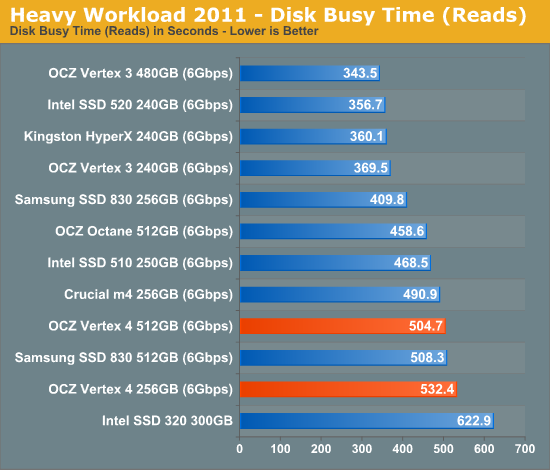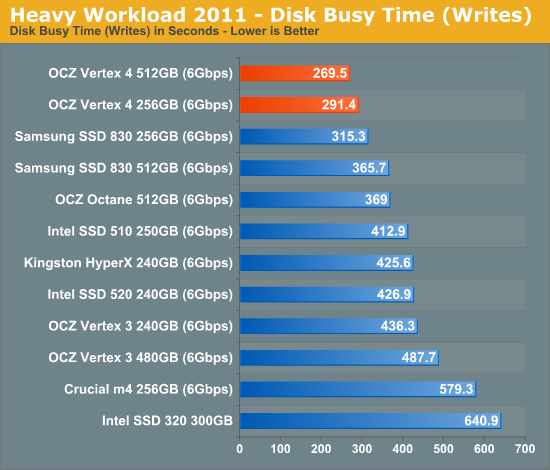OCZ Vertex 4 Review (256GB, 512GB)
by Anand Lal Shimpi on April 4, 2012 9:00 AM ESTAnandTech Storage Bench 2011
Two years ago we introduced our AnandTech Storage Bench, a suite of benchmarks that took traces of real OS/application usage and played them back in a repeatable manner. I assembled the traces myself out of frustration with the majority of what we have today in terms of SSD benchmarks.
Although the AnandTech Storage Bench tests did a good job of characterizing SSD performance, they weren't stressful enough. All of the tests performed less than 10GB of reads/writes and typically involved only 4GB of writes specifically. That's not even enough exceed the spare area on most SSDs. Most canned SSD benchmarks don't even come close to writing a single gigabyte of data, but that doesn't mean that simply writing 4GB is acceptable.
Originally I kept the benchmarks short enough that they wouldn't be a burden to run (~30 minutes) but long enough that they were representative of what a power user might do with their system.
Not too long ago I tweeted that I had created what I referred to as the Mother of All SSD Benchmarks (MOASB). Rather than only writing 4GB of data to the drive, this benchmark writes 106.32GB. It's the load you'd put on a drive after nearly two weeks of constant usage. And it takes a *long* time to run.
1) The MOASB, officially called AnandTech Storage Bench 2011 - Heavy Workload, mainly focuses on the times when your I/O activity is the highest. There is a lot of downloading and application installing that happens during the course of this test. My thinking was that it's during application installs, file copies, downloading and multitasking with all of this that you can really notice performance differences between drives.
2) I tried to cover as many bases as possible with the software I incorporated into this test. There's a lot of photo editing in Photoshop, HTML editing in Dreamweaver, web browsing, game playing/level loading (Starcraft II & WoW are both a part of the test) as well as general use stuff (application installing, virus scanning). I included a large amount of email downloading, document creation and editing as well. To top it all off I even use Visual Studio 2008 to build Chromium during the test.
The test has 2,168,893 read operations and 1,783,447 write operations. The IO breakdown is as follows:
| AnandTech Storage Bench 2011 - Heavy Workload IO Breakdown | ||||
| IO Size | % of Total | |||
| 4KB | 28% | |||
| 16KB | 10% | |||
| 32KB | 10% | |||
| 64KB | 4% | |||
Only 42% of all operations are sequential, the rest range from pseudo to fully random (with most falling in the pseudo-random category). Average queue depth is 4.625 IOs, with 59% of operations taking place in an IO queue of 1.
Many of you have asked for a better way to really characterize performance. Simply looking at IOPS doesn't really say much. As a result I'm going to be presenting Storage Bench 2011 data in a slightly different way. We'll have performance represented as Average MB/s, with higher numbers being better. At the same time I'll be reporting how long the SSD was busy while running this test. These disk busy graphs will show you exactly how much time was shaved off by using a faster drive vs. a slower one during the course of this test. Finally, I will also break out performance into reads, writes and combined. The reason I do this is to help balance out the fact that this test is unusually write intensive, which can often hide the benefits of a drive with good read performance.
There's also a new light workload for 2011. This is a far more reasonable, typical every day use case benchmark. Lots of web browsing, photo editing (but with a greater focus on photo consumption), video playback as well as some application installs and gaming. This test isn't nearly as write intensive as the MOASB but it's still multiple times more write intensive than what we were running in 2010.
As always I don't believe that these two benchmarks alone are enough to characterize the performance of a drive, but hopefully along with the rest of our tests they will help provide a better idea.
The testbed for Storage Bench 2011 has changed as well. We're now using a Sandy Bridge platform with full 6Gbps support for these tests.
AnandTech Storage Bench 2011 - Heavy Workload
We'll start out by looking at average data rate throughout our heavy workload test:
The overall score here is in-line with the SF-2281 solutions and OCZ's Octane. Our heavy workload is fairly write intensive, so I honestly expected the Vertex 4 to top the charts. Looking at the read/write breakdown explains why though:

Here we see the Vertex 4's poor low queue-depth sequential read performance rearing its head once more. Look at the sequential write speed and you'll see where OCZ makes up for its shortcomings however. The Vertex 4 writes quicker than any drive we've tested.

It's a tough tradeoff to come to terms with. The Vertex 4 delivers performance when it matters the most, but typically you want the absolute best performance regardless of workload. All of this may become moot if OCZ is able to address the situation with a firmware update in the coming weeks like it promised, but for buyers today it is something you have to think about.
The next three charts just represent the same data, but in a different manner. Instead of looking at average data rate, we're looking at how long the disk was busy for during this entire test. Note that disk busy time excludes any and all idles, this is just how long the SSD was busy doing something:














127 Comments
View All Comments
vol7ron - Wednesday, April 4, 2012 - link
Exactly, and it's where power consumption matters even more.I'd also like to see where the OWC drives fit in.
ViviTheMage - Wednesday, April 4, 2012 - link
There are plenty of lower pwer SSD's that have similiar tasty iops, so you won't be disappointed...the falvouring is a little different, but you will still enjoy it.ckryan - Wednesday, April 4, 2012 - link
I very much expect the next generation of Marvell drives to look similar in some respects to the V4.I applaud OCZ for doing things differently, but they're probably just trying to beat the next wave of Marvell powered drives to market, not making up for SFs immediate deficiencies.
ViviTheMage - Wednesday, April 4, 2012 - link
Do you think Marvell can release a drive with as many delicious iops?Kristian Vättö - Wednesday, April 4, 2012 - link
Not Marvell, because they only make controllers ;-)Plextor M3 Pro is already providing up to 75K/69K IOPS (read/write). Marvell released a new controller a couple of weeks ago and at least according to the press release, random speeds should be substantially improved with a great firmware. How fast is still a question but I wouldn't be surprised to see figures similar to Indilinx 2.
And as a side note, Plextor M3 review should be up later today or tomorrow as well :-)
ckryan - Wednesday, April 4, 2012 - link
The M3P is fantastic. It's like the V4 without the compromise. Plus, I'd take better low QD performance any day of the week over high QD performance. The M3P is a lot more balanced.Plus, yeah, the 830 is awesome too, but it doesn't really cater to the super high 4Krw crowd. I feel like OCZ just needed to get this drive out before then next wave of similar drives hit, and will later tweak the FW to better accommodate desktop workloads.
But it does accomplish one thing -- whatever FW/FTL they strapped on that drive doesn't look like anything else at the moment. It's certainly easy to see in an ocean of charts.
I think OCZ just mainly wanted to reverse their years of SF marketing practice with the V4 -- Latency is now important. Compressible data is out. They just had to wait until they had a product that could match the paper specs of the 2281. Ironically, I'd take it over a V3 any day of the week, but the 2281 is still better with most workloads.
etamin - Wednesday, April 4, 2012 - link
Perhaps the V4 may turn out to be a more economical choice though because it is entirely developed in house.jwilliams4200 - Thursday, April 5, 2012 - link
LOL. Except for the rebadged Marvell controller and the flash memory, yeah, entirely in house.rw1986 - Friday, April 6, 2012 - link
rebadged MRVL controller?? can u elaboratejwilliams4200 - Friday, April 6, 2012 - link
Did you ever wonder why Indilinx took so long to come out with a 2nd gen controller after their first was so popular?Well, they didn't. Not really. OCZ does not want you to know that they have a relationship with Marvell, and their new controller is basically a Marvell 88SS9187. It would be hard to justify the shareholder money OCZ spent on acquiring Indilinx if the truth were known.
If you have any doubts, look at the press release from Marvell press release bullet points and compare them to the features OCZ is touting in the Vertex 4. They are identical.
http://www.marvell.com/company/news/pressDetail.do...